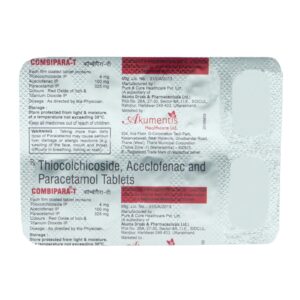PARACETAMOL + ACECLOFENAC + THIOCOLCHICOSIDE
Paracetamol: Paracetamol, also known as acetaminophen, is a widely used over-the-counter medication for the relief of pain and reduction of fever. It belongs to the class of drugs known as analgesics (pain relievers) and antipyretics (fever reducers).
Paracetamol works by inhibiting the production of prostaglandins, which are chemicals in the body that play a role in pain and fever. By reducing the production of prostaglandins in the brain, paracetamol helps alleviate pain and lower body temperature.
It is commonly used to relieve mild to moderate pain, such as headaches, toothaches, menstrual cramps, and muscle aches. It is also effective in reducing fever associated with various infections and illnesses.
The typical recommended adult dose of paracetamol is 325-650 mg every 4-6 hours, with a maximum daily dose of 4,000 mg. It is important to adhere to the recommended dosage instructions and not exceed the maximum daily dose, as excessive use can lead to liver damage.
Paracetamol is generally considered safe when used as directed. However, like any medication, it can have side effects. Common side effects include nausea, vomiting, upset stomach, and a skin rash. Rare but serious side effects can occur, such as severe allergic reactions or liver damage, especially if the recommended dosage is exceeded or if alcohol is consumed while taking the medication.
It is essential to read and follow the instructions on the package and consult a healthcare professional if you have any questions or concerns about using paracetamol, especially if you have an existing medical condition or are taking other medications.
Aceclofenac: Aceclofenac is a nonsteroidal anti-inflammatory drug (NSAID) that is primarily used to relieve pain and inflammation associated with various conditions such as osteoarthritis, rheumatoid arthritis, and ankylosing spondylitis. It belongs to the class of drugs known as phenylacetic acid derivatives.
The mechanism of action of Aceclofenac involves inhibiting an enzyme called cyclooxygenase (COX), which is responsible for the synthesis of prostaglandins, mediators of pain and inflammation. By inhibiting COX, Aceclofenac helps to reduce pain, inflammation, and fever.
The recommended dose of Aceclofenac may vary depending on the condition being treated and the severity of symptoms. Generally, the starting dose is 100 mg taken orally once or twice a day. However, the dose can be adjusted by a healthcare professional based on individual response and tolerance.
Like other NSAIDs, Aceclofenac can have several side effects. Common side effects may include nausea, stomach pain, indigestion, diarrhea, and headache. Less frequently, it can cause dizziness, rash, itching, swelling, and hypersensitivity reactions. In rare cases, Aceclofenac can lead to serious side effects such as gastrointestinal bleeding, kidney problems, and cardiovascular events like heart attack and stroke. Long-term use of high doses can increase the risk of these adverse events.
It is important to note that Aceclofenac should not be used in certain situations, such as in patients with a history of allergies to NSAIDs, asthma, peptic ulcers, bleeding disorders, or severe liver or kidney impairment. It is also not recommended in pregnant women, particularly during the third trimester, as it can harm the fetus.
As with any medication, it is crucial to follow the prescribed dose and consult a healthcare professional for guidance. They can provide personalized advice and monitor for any potential side effects or interactions with other medications.
Thiocolchicoside: Thiocolchicoside is a muscle relaxant drug used to treat muscular pain and spasms. It is commonly prescribed for conditions like lower back pain, neck pain, and muscle stiffness.
The drug works by affecting the central nervous system, specifically the gamma-aminobutyric acid (GABA) receptors in the brain and spinal cord. Thiocolchicoside enhances the activity of GABA, which is an inhibitory neurotransmitter that helps regulate muscle tone. By increasing GABA activity, the drug suppresses the transmission of pain signals and reduces muscle spasms, resulting in muscle relaxation and pain relief.
Thiocolchicoside is typically available as oral tablets or as a topical cream or gel for local application. The dosage and duration of treatment may vary depending on the individual’s condition and the prescribing doctor’s instructions. It is important to follow the recommended dosage and not exceed the prescribed duration of treatment.
Like any medication, Thiocolchicoside may have some side effects. Common side effects include drowsiness, dizziness, headache, nausea, digestive discomfort, and skin reactions (in case of topical application). These side effects are usually mild and temporary. However, if any side effects persist or worsen, it is important to consult a healthcare professional. Some individuals may also experience allergic reactions to Thiocolchicoside, which require immediate medical attention.
Thiocolchicoside is not suitable for everyone. Individuals with liver or kidney disease, a history of seizures, or sensitivity to colchicine (a related drug) should exercise caution or avoid using this medication. It is important to consult a healthcare professional before starting Thiocolchicoside to ensure safety and determine if it is the appropriate treatment option.

